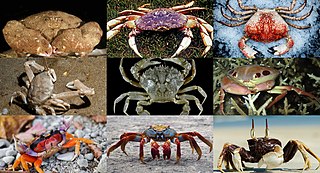
Crabs are decapod crustaceans of the infraorder Brachyura, which typically have a very short projecting tail-like abdomen, usually hidden entirely under the thorax. They live in all the world's oceans, in freshwater, and on land. They are generally covered with a thick exoskeleton. They generally have five pairs of legs, and they have pincer claws on the ends of the frontmost pair. They first appeared during the Jurassic period, around 200 million years ago.

Hermit crabs are anomuran decapod crustaceans of the superfamily Paguroidea that have adapted to occupy empty scavenged mollusc shells to protect their fragile exoskeletons. There are over 800 species of hermit crab, most of which possess an asymmetric abdomen concealed by a snug-fitting shell. Hermit crabs' soft (non-calcified) abdominal exoskeleton means they must occupy shelter produced by other organisms or risk being defenseless.

The New Zealand pea crab, is a species of small, parasitic crab that lives most commonly inside New Zealand green-lipped mussels. Adult females are about the size and shape of a pea, while adult males are smaller and flatter. Adult New Zealand pea crabs are completely reliant on their host mussel for shelter and food, which it steals from the mussel's gills. The New Zealand pea crab is found throughout New Zealand and can infect up to 70% of natural populations. These crabs are of concern to green-lipped mussel aquaculture because they reduce the size and growth of mussels, although infected mussels can be harvested and consumed.
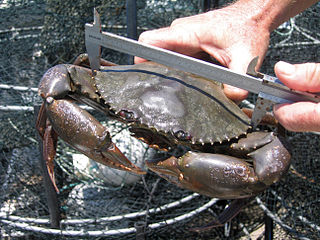
Scylla serrata is an ecologically important species of crab found in the estuaries and mangroves of Africa, Australia, and Asia. In their most common forms, their shell colours vary from a deep, mottled green to very dark brown.

Lophorhothon is a genus of hadrosauroid dinosaur from the Late Cretaceous of Alabama and North Carolina. It was the first genus of dinosaur discovered in Alabama, in the United States.
Golden crab may refer to:

Mourasuchus is an extinct genus of giant, aberrant caiman from the Miocene of South America. Its skull has been described as duck-like, being broad, flat, and very elongate, superficially resembling Stomatosuchus from the Late Cretaceous.
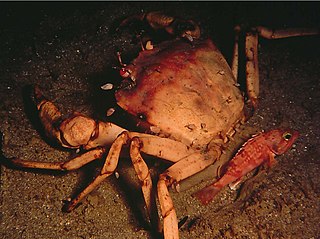
Chaceon fenneri, commonly known as the golden crab or golden deepsea crab, is one of several species of crab harvested for food by humans. It was formerly called Geryon fenneri. Like the blue crab, its common name comes from the color of its shell; it is usually cream to tan in color. Both parts of the binomen Chaceon fenneri commemorate Fenner A. Chace Jr. It is found on the ocean floor at depths of 200 to 1,500 m (660–4,920 ft) in the tropical west Atlantic, ranging from the Gulf of Mexico to Brazil. It cannot swim. The carapace of this large crab measures up to 20 cm (7.9 in), making the entire animal similar in size to a dinner plate. Its diet includes benthic (bottom-dwelling) organisms like mollusks and worms.

Geryon trispinosus is a species of crab that lives in deep water in the north-eastern Atlantic Ocean.
Gaffkaemia is a bacterial disease of lobsters, caused by the Gram-positive lactic acid bacterium Aerococcus viridans var. homari.
Hypothalassia acerba is a large crab found in the muddy substrates of the deep seas off the southwestern Australian and New Zealand coasts. Australian distribution, which is correlated to depth and temperature, ranges from a latitude as far north as approximately 27° S on the west coast, southwards, then eastwards on the south coast to a longitude of at least 129° E. The species usually occurs in waters with temperatures of 13–19 °C (55–66 °F) and in depths ranging of 200–255 metres (656–837 ft) on the lower west coast and 90–200 m (300–660 ft) on the south coast. Body size is inversely related to depth of water. There are only two species in the genus Hypothalassia, and H. acerba is not the same champagne crab as the other Hypothalassia species, H. armata, which is found in Japanese waters.
Jasus caveorum is a species of spiny lobster found on a single seamount in the southeastern Pacific Ocean, discovered in 1995 by fishermen from New Zealand. It is most similar to Jasus frontalis from the nearby Juan Fernández Islands, but is more closely related to species from the Atlantic and Indian Oceans.

Geryonidae is a family of crabs, including the following subfamilies and genera:

Geryon trispinosus is a species of crab that lives in deep water in the north-eastern Atlantic Ocean.
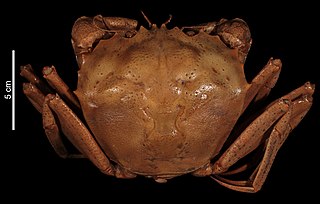
Chaceon crosnieri is a species of crab.
Chaceon bicolor is a species of crab.

Chaceon is a crab genus in the family Geryonidae, and was first described in 1989 by Raymond Manning and Lipke Holthuis.
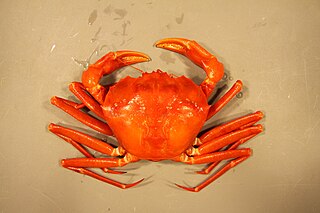
Chaceon quinquedens, commonly known as the red deep-sea crab, but sold as Atlantic deep sea red crab, or simply Atlantic red crab or red crab, is a crab that lives in the Atlantic Ocean off the East Coast of the United States and Canada, from North Carolina to Nova Scotia, and in the Gulf of Mexico.

Chaceon affinis is a deep-sea crab in the family Geryonidae. It was fist described in 1894 based on specimens caught off the Azores by the yacht L'Hirondelle. The species is found in the Atlantic from 140 to 2,000 m metres deep. They have a carapace length of 8 to 12 cm.











